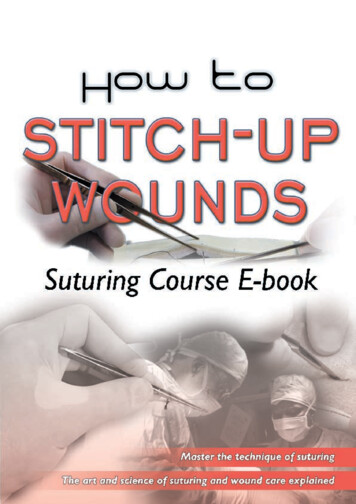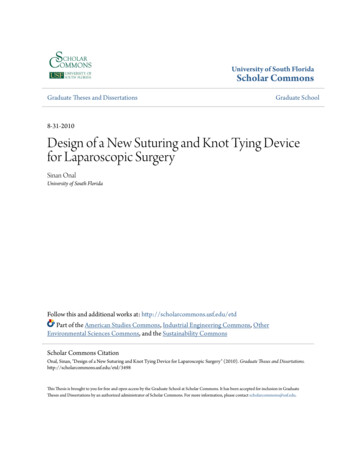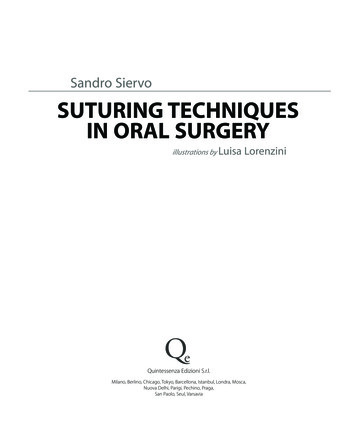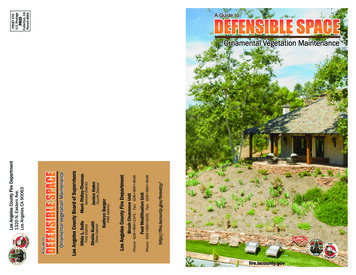
Transcription
VEADRTwww.joms.orgGUIDE TO SUTURINGwith Sections on Diagnosing Oral Lesions andPost-Operative MedicationsINSEAugust 2015 Volume 73 Supplement 1 pp 1-62RTJournal of Oral and Maxillofacial SurgeryAugust 2015 Volume 73 Supplement 1ElsevierYJOMS v73 i8 sS COVER.indd 123-07-2015 04:49:39
Journal of Oral andMaxillofacial SurgerySubscriptions:Yearly subscription rates: United States and possessions: individual, 330.00 student and resident, 221.00; single issue, 56.00. Outside USA: individual, 518.00; student and resident, 301.00; singleissue, 56.00. To receive student/resident rate, orders must be accompanied by name of affiliatedinstitution, date of term, and the signature of program/residency coordinator on institution letterhead. Orders will be billed at individual rate until proof of status is received. Prices are subject tochange without notice. Current prices are in effect for back volumes and back issues. Single issues,both current and back, exist in limited quantities and are offered for sale subject to availability.Back issues sold in conjunction with a subscription are on a prorated basis. Correspondenceregarding subscriptions or changes of address should be directed to JOURNAL OF ORAL ANDMAXILLOFACIAL SURGERY, Elsevier Health Sciences Division, Subscription Customer Service,3251 Riverport Lane, Maryland Heights, MO 63043. Telephone: 1-800-654-2452 (US and Canada);314-447-8871 (outside US and Canada). Fax: 314-447-8029. E-mail: journalscustomerservice-usa@elsevier.com (for print support); journalsonlinesupport-usa@elsevier.com (for online support).Changes of address should be sent preferably 60 days before the new address will become effective.Missing issues will be replaced free of charge if the publisher is notified at the above address within2 months of publication of the issue for US subscribers and within 4 months for subscribers from allother countries.Editorial:Editorial correspondence and manuscripts should be submitted online at http://ees.elsevier.com/joms/. The Notice to Contributors, which lists manuscript requirements in more detail, is availableon the Journal’s website, www.joms.org/authorinfo.Permissions:Permissions may be sought directly from Elsevier’s Global Rights Department in Oxford, UK;phone: (215) 239-3804 or 44 (0) 1865 843830, fax: 44 (0) 1865 853333. Requests may also becompleted online via the Elsevier homepage ht Ó 2015 by the American Association of Oral and Maxillofacial Surgeons. All rightsreserved. No part of this publication may be reproduced or transmitted in any form or by anymeans, now or hereafter known, electronic or mechanical, including photocopying, recording, orany information storage and retrieval system, without permission in writing of the publisher.Printed in the United States of America.The appearance of the code at the bottom of the first page of an article in this journal indicatesthe copyright owner’s consent that copies of the article may be made for personal or internal use,or for the personal or internal use of specific clients, for those registered with the CopyrightClearance Center, Inc. (222 Rosewood Drive, Danvers, MA 01923; 1-978-750-8400; www.copyright.com). This consent is given on the condition that the copier pay the stated per-copy fee for thatarticle through the Copyright Clearance Center, Inc. for copying beyond that permitted by Sections107 or 108 of the US Copyright Law. This consent does not extend to other kinds of copying, such ascopying for general distribution, for advertising or promotional purposes, for creating new collectiveworks, or for resale. Absence of the code indicates that the material may not be processed through theCopyright Clearance Center, Inc.Reprints:For 100 or more copies of an article in this publication, please contact Derrick Imasa at 212-6333874, Elsevier Inc., 360 Park Ave South, New York, NY 10010-1710. Fax: 212-462-1935;e-mail: reprints@elsevier.com. Reprints of single articles available online may be obtained by purchasing Pay-Per-View access for 30 per article on the Journal’s website, www.joms.org.Advertising:For information concerning placement of commercial advertising, please contact Joan Coffey atElsevier, 360 Park Avenue South, New York, NY 10010. Tel: (212) 633-3806; fax: (212) 633-3820.For information concerning placement of classified advertising, please contact Ariel Medina atElsevier, 360 Park Avenue South, New York, NY 10010. Tel: (212) 633-3689; fax: (212) 633-3820.Advertising guidelines are available upon request.Journal of Oral andMaxillofacial Surgery:is covered in Index Medicus, Current Contents/Clinical Medicine, Science Citation Index, ASCA(Automatic Subject Citation Alert), ISI/Biomed, Cinahl, the Index to Dental Literature, and theHospital Literature Index.
Journal of Oral andMaxillofacial SurgeryEditor-in-ChiefJames R. HuppEditors EmeritiDaniel M. LaskinLeon A. AssaelAssociate EditorSection EditorsThomas B. DodsonJohn H. CampbellDentoalveolar SurgeryJeffrey D. BennettAnesthesia/Facial PainMichael S. BlockImplantsM. Anthony PogrelPathologyEdward Ellis IIICraniomaxillofacial TraumaMichael MiloroCraniomaxillofacial Deformities/Cosmetic SurgeryEric R. CarlsonSurgical Oncology and ReconstructionJanie DunhamNewsShahrokh C. BagheriScott B. BoydStephanie J. DrewElie M. FerneiniDavid E. FrostLeonard B. KabanJ. Michael McCoySamuel J. McKennaDavid H. PerrottFaisal A. QuereshyC. Randolph ToddTrevor E. TreasureBrent B. WardInternational EditorialBoardAsri Arumsari - IndonesiaPeter Brennan - United KingdomNardy Casap - IsraelLim Kwong Cheung - Hong KongAnn C. Collins - AustraliaKyung-Wook Kim - KoreaReha Kisnisci - TurkeyMohammad H.K. Motamedi - IranKenichiro Murakami - JapanAlexander D. Rapidis - GreeceGeorge K. B. S andor - FinlandDarryl Tong - New ZealandCorrado Toro - ItalyJia Wei Zheng - ChinaContinuing EducationCharles N. BertolamiEditorial BoardStatistical ReviewerManaging EditorPublisherSung-Kiang ChuangCarmen E. HuppElizabeth PerillMichele WillmunderJournal Manager
www.joms.orgAugust 2015 Volume 73 Supplement 1GUIDE TO SUTURINGwith Sections on Diagnosing Oral Lesionsand Post-Operative MedicationsEditor: James R. Hupp, DMD, MD, JD
AAOMS BOARD OF TRUSTEESOfficersWilliam J. Nelson, DDSPresidentEric T. Geist, DDSImmediate Past PresidentLouis K. Rafetto, DMDPresident-ElectRobert C. Rinaldi, PhD, CAEExecutive DirectorDouglas W. Fain DDS, MD, FACSVice PresidentSteven R. Nelson, DDS, MSSpeaker, House of DelegatesBrett L. Ferguson, DDSTreasurerTrusteesVictor L. Nannini, DDSTrustee, District I(Northeastern)Paul M. Lambert, DDSTrustee, District IV(Great Lakes)Vincent E. DiFabio, DDS, MSTrustee, District II(Middle Atlantic)B.D. Tiner, DDS, MD, FACSTrustee, District V(Midwestern)J. David Johnson, Jr., DDSTrustee, District III(Southeastern)A. Thomas Indresano, DMDTrustee, District VI(Western)CONTRIBUTORS TO GUIDE TO SUTURING:Sections I, II and IVSection IIIJames R. Hupp, DMD, MD, JDEdward Ellis III,2 DDS, MSJames R. Hupp,1 DMD, MD, JD1Founding Dean and Professor of Oral-Maxillofacial SurgerySchool of Dental Medicine, East Carolina University1 Professor and Department Chair, Oral and Maxillofacial Surgery,School of Dentistry, University of Texas Health Science Center San Antonio2
Journal of Oral andMaxillofacial SurgeryVOLUME 73, SUPPLEMENT 1, AUGUST 2015Guide to Suturing1Letter of WelcomeWilliam J. NelsonSection I2IntroductionSection II3Oral Surgery Suturing4Introduction to Suturing6Instrumentation17Suturing TechniquesSection III30Surgical PathologySection IV57Postoperative MedicationsExcept where specifically stated, the opinions expressed or statements made in articles oreditorials are not endorsed by nor represent official policy of the American Association ofOral and Maxillofacial Surgeons or the publisher, Elsevier. Publication of an advertisementin this journal does not imply endorsement of the product or service by the AmericanAssociation of Oral and Maxillofacial Surgeons or Elsevier. Conflict of InterestDisclosures: None of the authors reported any disclosures.
GUIDE TO SUTURINGLetter of WelcomeCongratulations. As a future dentist, you will soon embark on an exciting career that offers unlimited opportunitiesfor personal growth and improving the oral health and lives of your patients. As you advance through your dentalschool curriculum, you will learn more about the nine ADA–recognized dental specialties and the skills and uniquetraining that set them apart from general dentistry and each other.Whether you decide to practice general dentistry or pursue a dental specialty, you will from time to timebe required to suture a wound or surgical incision in the oral cavity. Successful suturing techniques require carefulattention to both function and esthetic concerns.The American Association of Oral and Maxillofacial Surgeons (AAOMS) believes it is vital that the dentist placing asuture is trained in the proper technique, the use of appropriate materials, and the potential consequences of animproperly placed suture. We are pleased to present you with this Guide to Suturing to assist you in perfectingyour suturing skills. We have also included information on biopsy techniques and prescription medication orderingthat we trust you will find useful as you provide care for your patients in dental school and in the future.The AAOMS is the professional association that represents the more than 9,000 oral and maxillofacial surgeonspracticing in the United States. As the surgical specialists of the dental profession, oral and maxillofacial surgeonsare the experts in face, mouth, and jaw surgery.Oral and maxillofacial surgeons enjoy a far-reaching scope of practice that includes dentoalveolar and implantsurgery, anesthesiology, management of facial injuries and deformities, treatment of oral, head, and neck cancer,and reconstructive and cosmetic surgery. It is an exciting surgical specialty that is both challenging and rewarding.As you consider your future in dentistry, I invite you to learn more about the specialty of oral and maxillofacialsurgery by visiting our Web site at AAOMS.org and our new patient site at MyOMS.org.Sincerely,William J. Nelson, DDSPresident, American Association of Oral and Maxillofacial Surgeons1
GUIDE TO SUTURINGSection I IntroductionThe field of oral and maxillofacial surgery has a broad scope, and specialists in this field provide a wide array ofservices to patients with problems that range from dental infections to head and neck malignancies. Oral andmaxillofacial surgeons remove impacted teeth, place implants, perform procedures to correct cleft and otherdentofacial deformities, fix hard and soft tissue injuries to the face and jaws, and manage complex oral and facialpathology, including reconstruction of the resulting deformity, among many other services. Oral and maxillofacialsurgeons regularly partner with general dentists to help provide specialty care for their patients.There are oral surgical procedures that are part of the broad scope of general dentistry. These include routine oralsurgery such as the extraction of teeth, suturing wounds, and biopsying suspicious soft tissue lesions. Oral andmaxillofacial surgery textbooks provide didactic guidance to help dental students learn these skills. However, itis cumbersome to bring textbooks into dental school preclinical learning suites or actual clinical settings, andeven more difficult for students who receive their textbooks electronically. Focused guides are better suited forserving as a laboratory or clinical resource when learning and mastering surgical skills. This is why this guidewas developed.Suturing a wound is fun and satisfying to perform. However, learning the various suturing techniques can bea trying experience. Suturing in the mouth further complicates the situation. Section II attempts to unravel themystery of placing and tying sutures. The key instruments and materials used for intraoral suturing are presented.A detailed description and heavily illustrated guide to suturing follows.Section III addresses the topic of diagnostic pathology, providing a well-reasoned approach to describing anddifferentiating oral lesions. A discussion of various biopsy techniques is then given to help the student be ableto surgically sample oral soft tissue, when indicated, and then submit the sample for examination by an oral andmaxillofacial pathologist.Section IV provides guidance on prescription writing. A succinct discussion follows of analgesics and antibioticscommonly used for the oral surgery patient. Just as with any of the skills needed to become a well-trained generaldentist, learning under the close guidance of expert faculty is required. This manual is intended to complementfaculty instruction. Also, just as with many of the surgical skills dentists acquire, there is an aspect of art in theirperformance. Therefore, individual faculty might share or prefer variations on the concepts presented in thefollowing pages.2
GUIDE TO SUTURINGSection II Oral Surgery SuturingThe ability to suture is one of the essential skills required of anyone planning to perform surgery. Although itcan appear to be a simple procedure, suturing properly requires a sound understanding of the biology of woundhealing, good hand–eye coordination, good judgment, and some finesse. Learning to suture in an expert mannerrequires an understanding of the proper techniques and dedicated practice.This section on suturing in this special student supplement is designed to guide dental students as they learn andmaster the suturing techniques most commonly used to close oral mucosa. Most of the techniques covered are alsoused in surgery performed elsewhere in the body.The suture section presumes that the student already possesses an understanding of the basic anatomy andphysiology of oral tissues and basic knowledge in soft tissue wound healing.This special supplement is not intended to serve as a self-instructional manual. Rather, it is meant to complementthe teaching of dental school faculty. Just as with any skill requiring manual actions, learning the various suturingtechniques is most effective and efficient when done under the careful supervision of educators who can provideneeded demonstrations and coaching.3
GUIDE TO SUTURINGSection IIA Introduction to Suturingprint & web 4C FPOOnce a surgical procedure is completed and the wound properly irrigated and debrided, the surgeon should returnelevated or incised tissue to its original position or, if necessary, place it in a new position, and hold it in place with sutures.Sutures perform multiple functions. The most obvious and important function that sutures perform is to coaptwound margins; that is, to hold the tissue in position and approximate the opposing wound edges. The sharperthe incision and less trauma inflicted on the wound margin, the more probable is healing by primary intention.If the space between the 2 wound edges is minimal, wound healing will be rapid and complete. If tears or excessivetrauma to the wound edges occur, wound healing might need to occur by secondary intention. Thus, when suturing a flap back into position or closing a biopsy site, the surgeon will usually attempt to use sutures to bring thewound edges into close contact. However, in cases in which healing by secondary intention is planned, such asafter the extraction of an erupted tooth, sutures are only used to reapproximate any papillae that were elevated.Sutures can also aid in hemostasis. When a flap has been used to gain access, suturing it back into position helps stopbleeding. If the underlying tissue is bleeding significantly, the surface mucosa or skin should not be closed, because thebleeding in the underlying tissue could continue and result in the formation of a hematoma. In such cases, better hemostasis should be achieved before wound closure. Similarly, overlying soft tissue should never be sutured tightly in anattempt to gain hemostasis of a bleeding tooth socket. Instead, direct pressure should be applied. Sutures can be usedas an aid in maintaining a blood clot in the alveolar socket. A special suture, such as a figure-of-eight suture, can providea barrier to clot displacement (Fig II-1). However, it should be emphasized that suturing across an open wound socketplays a minor role in maintaining the blood clot in the tooth socket. However, the figure-of-eight suture can help retainprocoagulant or other materials placed into a socket. (The figure-of-eight suture is further discussed in Section II-C.)FIGURE II-1. A, The figure-of-eight suture, occasionally placed over the top of the socket to aid in hemostasis.B, This suture can be used to hold elevated papillae back into proper position and to help maintain oxidizedcellulose placed in a tooth socket to promote coagulation. Reprinted with permission from Hupp1.4
SECTION IIA5Sutures help hold a soft tissue flap over bone. This is an important function because bone that is not covered withsoft tissue becomes nonvital and requires an excessively long time to heal. When mucoperiosteal flaps are reflectedfrom alveolar bone, it is important that the extent of the bone be recovered with soft tissue flaps. Unless appropriatesuture techniques are used, the flap can retract away from bone, which exposes it and results in delayed healing.The surgeon must remember that the purpose of the suture is merely to reapproximate the tissue; therefore, thesuture should not be tied too tightly. Sutures that are too tight will cause ischemia of the flap margin and result intissue necrosis, with eventual tearing of the suture through the tissue. Thus, sutures that are too tightly tied willresult in wound dehiscence more frequently than sutures that are loosely tied. As a clinical guideline, no blanchingor obvious ischemia of the wound edges should be present. If this occurs, the suture should be removed andreplaced. The knot should be positioned so that it does not fall directly over the incision line, because this causesadditional pressure on the wound. Therefore, the knot should be positioned to the side of the incision line.Reference1. Hupp JR, Ellis III E, Tucker MR: Contemporary Oral And Maxillofacial Surgery (ed 6). St. Louis, MO, Elsevier, 2014
GUIDE TO SUTURINGSection IIB InstrumentationRoutine extraction of a tooth does not automatically create the need to place sutures. However, if interdentalpapillae have been cut or inadvertently torn, or a flap has been raised, suturing is usually indicated. This sectionwill discuss the instruments and materials used for suturing in the oral cavity.Needle Holderprint & web 4C FPOThe needle holder is an instrument with a locking handle and a short, blunt beak. For intraoral placement ofintraoral sutures, a 6-in. (15-cm) needle holder is usually recommended (Fig II-2). The beaks of a needle holderare shorter and stronger than the beaks of a hemostat, an instrument not designed to hold a suture needle. Theface of a beak of the needle holder is cross-hatched to permit a positive grasp of the suture needle. The hemostathas parallel grooves on the face of the beaks, thereby decreasing the control over the needle and suture. Therefore,the hemostat is not used for suturing (Fig II-3).FIGURE II-2. A needle holder has a locking handle and a short, stout beak. Reprinted with permission fromHupp1.6
SECTION IIB7Aprint & web 4C FPOBFIGURE II-3. A, A hemostat (Top) has a longer, thinner beak compared with the needle holder (Bottom) and,therefore, should not be used for suturing. B, The faces of the beaks of the needle holder are cross-hatched to ensurea positive grip on the needle (Left). The faces of the hemostat have parallel grooves that do not allow a firm grip onthe needle (Right). Reprinted with permission from Hupp1.
8INSTRUMENTATIONTo control the locking handles of the needle holder properly and to direct the beaks of the needle holder, thesurgeon must hold the instrument properly (Fig II-4). The thumb and ring finger are inserted through the rings.The index finger is held along the length of the needle holder to steady and direct it. The second finger aids incontrolling the locking mechanism. The index finger should not be put through the finger ring, because thiswill result in a dramatic decrease in control.Aprint & web 4C FPOBFIGURE II-4. A, The needle holder is held using the thumb and ring finger in the rings, allowing them to openand close and unlock the needle holder. B, The first and second fingers help direct the instrument. Reprintedwith permission from Hupp1.
SECTION IIB9Tissue Forcepsprint & web 4C FPOMany surgeons prefer to grasp soft tissue with an instrument while suturing. The tissue forceps commonly usedfor this purpose for dentoalveolar suturing are the Adson forceps (or pickups; Fig II-5). These are delicate forceps,with or without small teeth at the tips, which can be used to hold tissue gently and thereby stabilize it. When thisinstrument is used, care should be taken not to grasp the tissue too tightly, crushing the tissue. Toothed forcepsallow tissue to be held with a more delicate grip than untoothed forceps. Adson forceps are also commonlyused when performing a biopsy (see Section III). Learning how to suture is challenging; thus, illustrations do notshow the use of tissue forceps while suturing. This approach to suturing is better demonstrated by an instructor.FIGURE II-5. A, Adson forceps (pickups) with teeth. The small, delicate toothed type of Adson forceps can beused to gently, but securely, grasp soft tissue while placing sutures or dissecting. B, Close-up view shows thefine teeth of forceps. Adson forceps also come without teeth (not shown). B, Reprinted with permission from Hupp1.
10INSTRUMENTATIONScissorsprint & web 4C FPOThe final instruments necessary for placing sutures are suture scissors (Fig II-6). Suture scissors usually have shortcutting edges because their sole purpose is to cut sutures. The most commonly used suture scissors for oral surgeryare Dean scissors. These scissors have slightly curved handles and offset serrated blades that make cutting sutureseasier. Suture scissors usually have long handles and thumb and finger rings. The scissors are held in the same wayas are needle holders.FIGURE II-6. A, B, Dean scissors are commonly used to cut sutures after tying the knot. The suture scissors shouldbe held in the same fashion as the needle holder. Reprinted with permission from Hupp1.
11SECTION IIBSuture NeedleSuture needles come in a large variety of shapes, from very small to very large (Fig II-7A). The needle used inclosing oral mucosal incisions is usually a small half-circle or three-eighths-circle suture needle. The needle iscurved to allow it to pass through a limited space that a straight needle cannot reach, and passage can be donewith rotation of the wrist.The tips of suture needles either are tapered similar to sewing needles or have triangular tips that allow themto be cutting needles. A cutting needle will pass through the mucoperiosteum more easily than a tapered needle(Fig II-7B). The cutting portion of the needle extends about one third the length of the needle, and the remainingportion of the needle is rounded. Tapered needles are used for more delicate tissues, such as in ocular or vascularsurgery. Care must be taken with cutting needles, because they can cut through tissue lateral to the track of theneedle if not used carefully or correctly. The suture material is usually purchased already swaged on (a means offusing the end of a suture onto a needle) by the manufacturer.ABprint & web 4C FPOABFIGURE II-7. A, The shapes and types of needles commonly used in oral surgery are the three-eighths-circle (Topand Middle) and half-circle (Bottom) cutting needles. Top, PS-2; Middle, FS-2; Lower, X-1. Notice how the sutureis securely swaged (press-fitted) onto the needle. B, Drawing of a cutting needle with a triangular cross-section.This allows the needle to glide through tissue such as gingiva more readily than a tapered (noncutting) needle.Reprinted with permission from Hupp1.
12INSTRUMENTATIONprint & web 4C FPOThe curved needle is held approximately two thirds of the distance between the tip and the base of theneedle (Fig II-8). This allows enough of the needle to be exposed to pass through the tissue while allowingthe needle holder to grasp the needle in its strong portion to prevent bending of the needle or dulling ofthe tip.FIGURE II-8. The needle holder grasps the curved needle about two thirds of the distance away from the tip of theneedle (termed ‘‘loading the needle holder’’). This usually allows enough of the needle to pass through tissue so thatthe surgeon can regrasp the needle below the tip. The needle should be held in the tips of the beaks of the needleholder for best control. Reprinted with permission from Hupp1.
SECTION IIB13Suture Materialprint & web 4C FPOMany types of suture materials are available. The materials are classified by diameter, resorbability, and filamenttype (monofilament or polyfilament).The size of a suture relates to its diameter and is designated by a series of zeros. The diameter most commonlyused in the suturing of oral mucosa is 3-0 (000). A larger size suture is 2-0, or 0. Smaller sizes are designated withmore zeros, for example 4-0, 5-0, and 6-0. Sutures of very fine size, such as 6-0, are usually used in conspicuousplaces on the skin; for example, the face, because properly placed smaller sutures usually cause less scarring.Sutures of size 3-0 are large enough to withstand the tension placed on them intraorally and strong enough for easierknot tying with a needle holder than smaller diameter sutures (Fig II-9A to E).print & web 4C FPOFIGURE II-9A. Surgical sutures come double-wrapped. This allows the nonsterile outer wrapper to be handledby unsterile hands. The outer packaging is designed so it can be peeled open, allowing the sterile inner pack to bedropped onto the sterile instrument tray or presented to someone with gloved hands to remove.FIGURE II-9B. The suture inner pack is labeled, describing the type and size of the suture and the type and shapeof the needle swaged onto the suture. In this case, this is a 4-0 absorbable chromic gut suture with a 3/8 circular,reversed cutting needle (C6 is the generic name of such a needle). The term ‘‘reversed’’ means that the triangularcross-section of the cutting needle points downward. The suture is 27 in. or 70 cm long. The diagram on thepackage shows the actual shape and size of the needle in the pack.
INSTRUMENTATIONprint & web 4C FPO14print & web 4C FPOFIGURE II-9C. The inner package is designed to be peeled open, exposing the contents. The contents will bemoist in this case, because this is a chromic gut suture that must be kept moist to allow proper suture handling whileplacing and knotting the suture. The thin cardboard in the pack is labeled on one side to show the suture size andscored to show the location of the underlying needle.print & web 4C FPOFIGURE II-9D. Folding down the designated corner reveals the needle lying in its own compartment, separatefrom the suture. The needle is ready to be grasped by a needle holder.FIGURE II-9E. Once the needle is grasped, the inner fold can be opened, revealing the suture carefully coiledto reduce the chance of tangling, as it is slowly unfurled.
SECTION IIB15Sutures can be resorbable or nonresorbable. Nonresorbable suture materials include such types as silk, nylon,vinyl, and stainless steel. The most commonly used nonresorbable suture in the oral cavity is silk. Nylon, vinyl,and stainless steel are rarely used in the mouth.Resorbable sutures are primarily made of gut. Although the term ‘‘catgut’’ is often used to designate this type ofsuture, the gut actually is derived from the serosal surface of sheep intestines. Plain catgut resorbs quickly in theoral cavity, rarely lasting longer than 3 to 5 days. Gut that has been treated by tanning solutions (chromic acid) andis, therefore, termed ‘‘chromic gut,’’ lasts longer—up to 7 to 10 days. Plain and chromic gut suture are packaged in amoist state to help preserve their suturing properties. If they dry out, they become brittle and will not easily passthrough tissue. Thus, when using a gut suture, it is important to not open the inner package until the surgeon isready to use it. If the suture becomes dry or caked with blood, the suture can be drawn through moistened gauzeto restore its working properties. Note that chromic gut suture should not be left soaking in any solution, becausethis will tend to leach out the chromic salts, speeding its tissue resorption. The composition and monofilamentnature of a gut suture gives it an unneeded elastic memory property. Thus, when the suture is drawn from thepackage, it tends to retain its curled form. Some of this elastic memory can be removed by gently tugging onthe suture to help straighten it.Several synthetic resorbable sutures are also available. These are materials that are long chains of polymersbraided into suture material. Examples include polyglycolic acid and polylactic acid. These materials are slowly resorbed, taking up to 4 weeks before they are resorbed. Such long-lasting resorbable sutures are rarely indicated inthe oral cavity for basic oral surgery.Finally, sutures are classified on the basis of being monofilament or polyfilament. Monofilament sutures aresutures such as plain and chromic gut, nylon, and stainless steel. Polyfilament sutures are braided sutures suchas silk, polyglycolic acid, and polylactic acid. Sutures made of braided material are easier to handle and tie, areless irritating to a patient’s tongue, and rarely come untied. The cut ends are usually soft and nonirritating tothe tongue and surrounding soft tissues. However, because
mystery of placing and tying sutures. The key instruments and materials used for intraoral suturing are presented. A detailed description and heavily illustrated guide to suturing follows. Section III addresses the topic of diagnostic pathology, providing a well-reasoned










